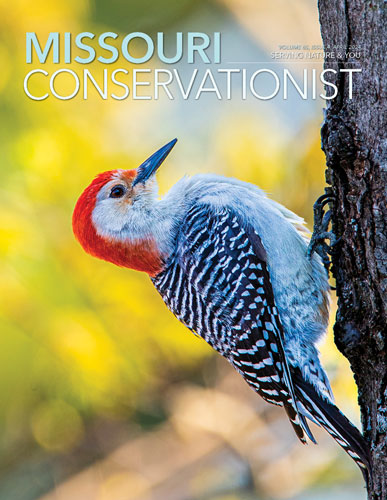Got a question for Ask MDC? Send it to AskMDC@mdc.mo.gov or call 573-522-4115, ext. 3848.
Q: We float-fished the upper Meramec River last spring and caught some smallmouth bass with vibrant red eyes. Is there a reason these had such vibrant red eyes and others were brown?
Several of the centrarchid bass — largemouth bass, rock bass, smallmouth bass — can have this eye pigment variation. It’s like humans having blue, green, and brown eyes. It is thought the red pigment may help them see better in the dark. It’s a somewhat common color variation throughout the state; it’s not unique to the Meramec.
Q: A nest of baby squirrels were nesting on a limb that broke off my tree. They don’t have their eyes open yet. How do I take care of them?
If you leave the squirrels and their nest in a protected place near where the branch fell, the mother squirrel should be able to carry them to safety. It’s best to leave them in place close by where you found them instead of trying to take care of them yourself. If pets and children are a concern, it’s acceptable to place the squirrels in an open container and attach it to the tree from which they fell so the parent can find them and carry them away.
Baby animals are rarely abandoned. The wildlife parent is afraid of people and will retreat when you approach. If the baby animal is left alone, the parent will usually return. In addition, wildlife parents cannot constantly tend to their young. Often, they spend many hours each day gathering food. For more information, visit short.mdc.mo.gov/4A5.
Q: I noticed this nest under an eave of my well house. I saw a bird fly to a nearby tree, but I could not get a good look at it. Could you tell me what bird made this nest?
This is an eastern phoebe’s nest. These flycatchers typically place their mud-and-grass nests in protected nooks on bridges, barns, and houses, thus boosting this species’ familiarity to humans. But they also build them near cliffs and cave openings where they forage for flying insects. During the early spring, they frequent areas near water, such as along a lakeshore, where emergences of insects are most likely to occur.
These birds prefer to build nests supported by shelves or ledges and out of the reach of ground predators. Females select the sites and build the nest exclusively, although males frequently accompany them. Nests are made of mud, green moss, some leaves, and lined with fine grass stems and hair. The green moss is an invariable component in nest construction and its presence is diagnostic, although late-season nests in dry periods can have less moss.
These birds are hardy; they winter farther north than most other flycatchers and are one of the earliest returning migrants in spring. For more information, visit short.mdc.mo.gov/47D.
And More...
This Issue's Staff
Editor - Angie Daly Morfeld
Associate Editor - Larry Archer
Photography Editor - Cliff White
Staff Writer - Kristie Hilgedick
Staff Writer - Joe Jerek
Staff Writer – Dianne Van Dien
Designer - Shawn Carey
Designer - Marci Porter
Photographer - Noppadol Paothong
Photographer - David Stonner
Circulation – Marcia Hale






















